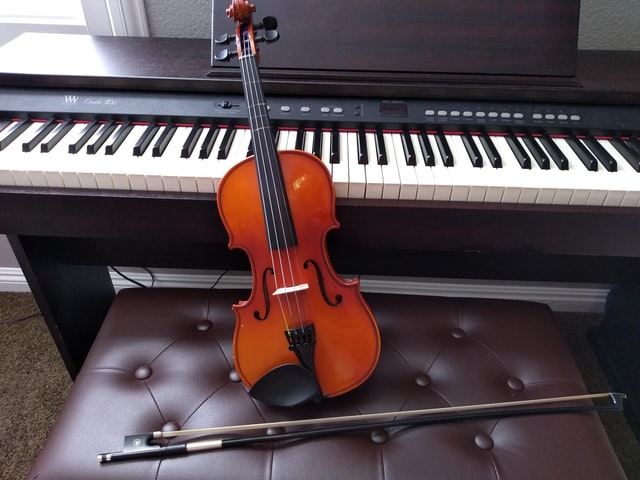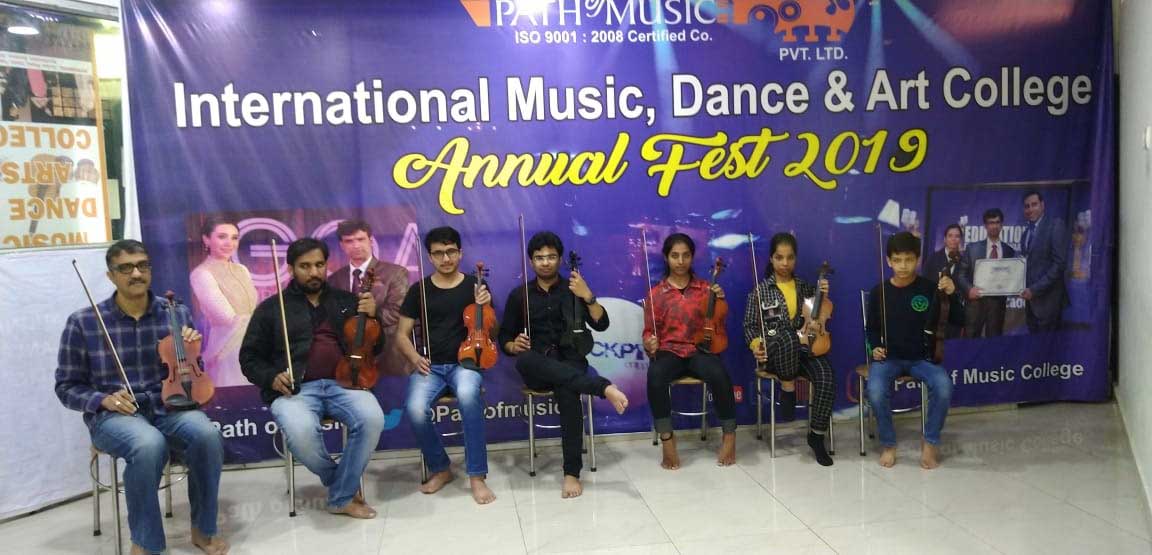Violin Classes & Lessons for children, teenagers, youth & adults

Over 28 Years of Teaching
Path of Music College Violin Classes for Beginners to Professionals
The strains of a violin tug directly at the heartstrings. Learn to express your musings with such a lovely instrument at Path of Music College. Violin has become an important musical instrument in Indian Music and Western music.
All it takes is a dainty instrument and a wispy bow to come in contact for some melodious hooks. Since its birth in the 16th century. The cry of a fiddle has managed to touch and sympathies souls through the generations. From Nicola Paganini and Pablo De Sara sate to Lindsey Sterling, David Garret and Bryson Andres.
They evolved phrases of the violin to bind people with their incomprehensible emotions through music. Fingering, Posture formation and bowing forms are techniques to be followed to reach their kind of majesticity. This instrument is involved in genres like Western Classical, Jazz, Country and Bluegrass. With a strong base, commitment, determination and enthusiasm, we will aid your experience of expressing yourself through the Violin.
Hence, the violin plays a prominent role in Indian music. There has been a lot of progress made by many great artists in terms of style and methodology in which Indian music is played on Violin. Since then, the artistry of playing Indian music on violin has been blossoming.
This Page is a humble attempt to prepare a vade mecum which introduces you to the history of Violin, the prodigious musicians/composers of Indian music and the great violin artisans of the yesteryears. This Page also comprises of a methodology in holding and playing which is prepared from the opinions and suggestions of great viewings and from an eclectic collection from various compendiums on violin.
ABBREVIATIONS
O– Open String
1f– Index Finger
2f– Middle Finger
3f– Ring Finger
4f– Little Finger
Definition: Violin
“A four-stringed instrument played with a bow. It is an unfettered fingerboard, consists of shallower body and capable of great flexibility in range, tone and dynamics”
History
There is cogent evidence that the bowed instrument was first manufactured and played in India. It has been confirmed by Engle (1874) that bowed instruments were played in India 2000 years ago Sonnerate, a French priest believed that 5000 years ago a bowed instrument called ‘Ravanastram’ was played by Ravana. Western Scholars researched regarding the same and penned the following lines in the ‘Violin’ category in “The Every Man Encyclopedia”.
History reveals that during the erstwhile century’s people of Persia and Arabian countries have travelled to India for various reasons like trade et cetera.
With reference to the history of bowed instruments in the 9th century in Europe, in the kingdom of the Byzantine Empire, there was an instrument called ‘lira’.
A Persian geologist called IbnKhurradadhbin who belonged to the 9th century was the first one who has authoritatively advised the Byzantine lira. Contemporaneously in the kingdom of Islamic Empires, there was an equivalent instrument called ‘rabab’ was in practice.
The Byzantine Lira had spread to entire Western Europe. During the 11th and 12th century, when the European writers had to refer a bowed instrument they used the words ‘fiddle’ and ‘lira’. At the same time, the instrument called ‘rabab’ has entered the Iberian Peninsula through Western Europe. These two bow instruments have spread to the whole of Europe and have helped for the further invention of bow instruments.
There were only two bowed instruments which have been used in the later centuries in Europe, which are as follows.
A square-shaped instrument fits in the hand, was given the Italian name which belonged to the family of Lira da Braccio (meaning veil for the arum).
The other instrument slid from the shoulders to the legs and was given the Italy name Lira da Gemba (or viola da gamba, meaning viol for the leg). During the Renaissance, the Gammas instrument was very special and important. But later due to Lira da Breccia, which belonged to the family of the Modern Violin, produced louder sounds and thus the gammas lost its existence completely.
The development was in the same manner until 1644-1737 where Antonius Stradivarius the student of Nicholas Amati independently developed a violin which could be used for stage performances, blend with all ease was manufactured.
The oldest confirmed surviving violin, dated inside, is the “Charles IX” by Andrea Amati, made in Cremona in 1564. The Metropolitan Museum of Art has an Amati violin that maybe even older, possibly dating to 1558. The famous artisans from 16 to 18th century who manufactured the violins are called ‘Luther’s’.

CHOOSE US
Why Learn With Us?
Established for Over 28 Years
Located in the Gurgaon
Over 10,000 Students
Award Winner Educators
Playing music makes you more creative
Practising and perfecting a piece of music does wonders for the creative side of your brain. No matter how much a composer annotates their composition, they cannot fully express how a piece of music should be played.
Send Us a Message Anytime!
Info
Contact or Visit Us
Email Address
Location
SCO-30, 2nd Floor, Sector 23 Market, Gurugram, Haryana, India – 122017
Phone Number
9650960136 | 01244382495



